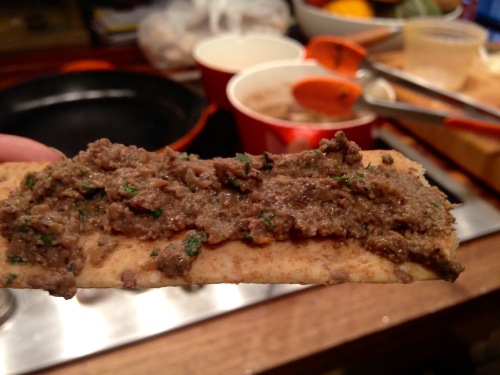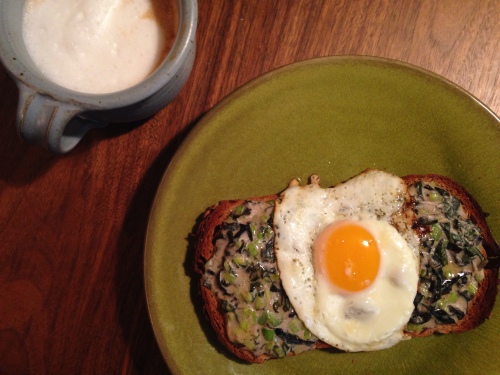Seven adults, an almost three-year-old, an almost two-year-old, and a baby born just six days ago are descending on my 600-square-foot apartment this afternoon. I spent the past week gathering ingredients from far and wide. I take a certain amount of pride in noting that nothing on today’s Thanksgiving table was sourced from a large grocery chain. I take a little less pride in the fact that I bought cheese in three different stores because I failed to actually make any sort of shopping list.
Our 17-pound turkey hails from Vermont and was procured through my CSA. It has been soaking up its dry brine since Tuesday night.
Last night was time for more prep work. I transformed a loaf of bread into rustic croutons. I made a slow-simmered turkey stock using the neck and a few other odds and ends, along with a little pancetta. I baked sweet and spicy candied pecans. I cooked up a batch of cranberry, apple and caramelized onion chutney. I did my best to tidy up the apartment.
Over the years, I have developed a system for helping myself stay on track when preparing an elaborate meal. Today’s game plan will continue to evolve throughout the day, but this is the general direction.
I inexplicably awoke at 7:00am, leaving me with more time than anticipated. It was too early to pull the bird out of the fridge. And, until I remove the bird, there’s pretty much no room for anything else I manage to prep ahead of schedule.
I pondered this dilemma over a cup of coffee until I remembered that turkey liver I had shoved in a bowl and stuck next to the mushrooms for the ciabatta, sausage, fennel and cremini stuffing. Suddenly I had a vision of the amazing chopped liver made by Maison David’s Michel Kailfa that I had the chance to sample during June’s study trip to Paris. Frenchmen don’t get much more charming that Michel. And chopped liver doesn’t get tastier than his.
But I would do my best.
Chopped Turkey Liver with Cremini Mushrooms
- 4 tablespoons olive oil
- 1 turkey liver
- 1 small onion, thinly sliced
- 1 sprig fresh thyme, leaves stripped
- 1 small pinch red pepper flakes
- 4 cremini mushrooms
- 3 tablespoons madeira
- 1 small handful flat leaf Italian parsley
- salt and pepper
- Bring half the oil up to medium heat in a small pan. Add the liver and sear, rotating as it browns, for approximately five minutes.) You’re aiming for something like a medium-rare steak.) Remove the liver to a small bowl and add the rest of the oil.
- Add the onion and continue to cook, stirring frequently, until they are nicely browned and limp. (I have a hunch that Michel takes his onions past this point, which may make all the difference.) Add the mushrooms, thyme leaves and red pepper. Continue cooking, stirring frequently. The mushrooms will soak up the remaining fat and then gradually release liquid. Once they have done so, add the madeira and cook stirring continuously and scraping the bottom of the pan until mostly evaporated.
- Dump the liver, onions and mushrooms, and parsley into the small bowl of your food processor and purée for a few minutes. Season to taste with salt and pepper.
Liver is packed full of good nutrients, including iron–which is good for those of us that tend towards the anemic. A smear of this on a cracker is a great way to get your strength up for a long day of cooking.


















